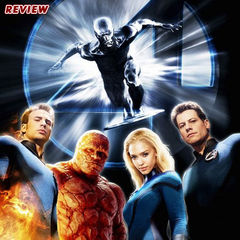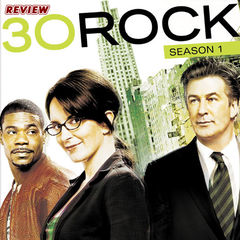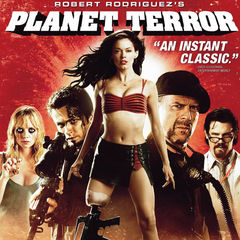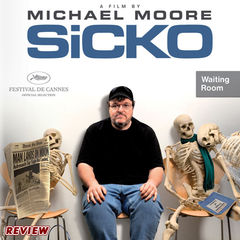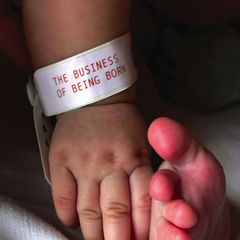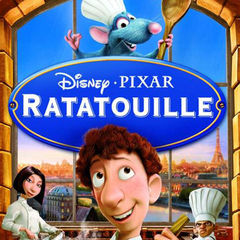REVIEW- FANTASTIC FOUR: RISE OF THE SILVER SURFER
June 18th, 2007 | by Tom









(5 votes, average: 6.80 out of 10)
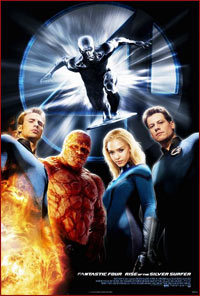 “Well, it’s not as bad as the first one.”
“Well, it’s not as bad as the first one.”
That may sound like faint praise, but it’s literally the best compliment anyone can pay to Fantastic Four: Rise of the Silver Surfer.
Despite a strong box office performance, after the original Fantastic Four movie from 2005 left such a bad taste in the mouth of fans and critics alike, expectations were low for the sequel. Of course then they had to come out with an excellent trailer to get our hopes up and seeing The Silver Surfer in action got the geek nation whipped up in a frenzy.
Oh, how they toy with our emotions.
For the most part, the film lives up to the hype. Finally able to set aside the clumsy exposition requirements of the first film, director Tim Story drops us square into the middle of the everyday life of our heroes. Each of them have settled into the roles of super-powered protectors, but not as media figures. As Mr. Fantastic (Ioan Gruffudd) and The Invisible Woman (Jessica Alba) prepare to walk down the aisle for the fourth time, the media instrusion makes it easy to see why there have been so many postponements.
This time, however, the interruption occurs at a more… cosmic scale – The Silver Surfer.
While most of the good moments with the Surfer were used up in that trailer that cause all of our attention, his exciting chase with The Human Torch (Chris Evans) sets the rest of the movie into motion. The Surfer is flying all over the world, causing weather disruptions and undertaking massive terraforming to prepare Earth for the consumption of his “master” – the devourer of worlds, Galactus. It then becomes the peroggitive of The Fantastic Four and a particularly abrasive Army General (Andre Braugher) to catch up to The Surfer and neutralize him.
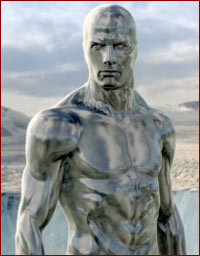 Everything The Surfer does is poetry in motion and a joy to watch on screen. Credit there can be given to Peter Jackson’s WETA Workshop in New Zealand and motion-capture performer Doug Jones. You don’t know Doug Jones, but you’re probably familiar with his work as the amphibian Abe Sapien in 2004’s Hellboy and most recently as the gruesome Pale Man and the titular Faun in last year’s Pan’s Labyrinth. His stoic, elegant performance as The Surfer speaks volumes although Jones himself does not. Laurence Fishburne provides his voice.
Everything The Surfer does is poetry in motion and a joy to watch on screen. Credit there can be given to Peter Jackson’s WETA Workshop in New Zealand and motion-capture performer Doug Jones. You don’t know Doug Jones, but you’re probably familiar with his work as the amphibian Abe Sapien in 2004’s Hellboy and most recently as the gruesome Pale Man and the titular Faun in last year’s Pan’s Labyrinth. His stoic, elegant performance as The Surfer speaks volumes although Jones himself does not. Laurence Fishburne provides his voice.
It’s when the Surfer is not on the screen that the movie begins to lose focus. Much of the movie is spent on The Invisible’s Woman insecurities surrounding her marriage and the ability to lead a normal life. The Human Torch is also the center of a sub-plot where he attempts to grow out of his showboating ways and become more of a team player. Meanwhile, Michael Chiklis as The Thing is almost completely left out. Useful only, it would seem, for crashing through walls or lifting heavy things.
While it probably isn’t easy to give equal time to each of the characters problems or focus on their fantastic powers, what does make it into the movie feels less like actual character development and more like details screenwriters Don Payne and Mark Frost tossed in to keep the movie from being a string of globe-trotting action pieces. But if they wanted to add something significant to the movie, they could have completely dumped Julian McMahon returning as Dr. Doom and shown us more of The Surfer and the sacrifice he made before becoming the herald of Galactus. As it is in the movie, his origin is delt with in a few line exchanges and they show us nothing. Doom’s presence in the movie felt like tacked on just to keep continuity with the first movie. They could have had him sit this one this one out and been totally fine.
A lot of movies this summer have been tagged for being too long. Rise of the SIlver Surfer is actually a movie that probably could have benefitted from another 20 minutes. Briskly burning through it’s 90 minute running time, I sometimes felt that I was watching the movie on fast forward. Or, perhaps, like I was just being shown storyboards brought to life. Director Tim Story’s history as a commercial and music video director is transparent on screen. His style lends itself well to our sound-bite culture. The action sequences are punctuated well with visuals that would work great for a trailer as a promotional photo, but rarely does it add up to anything substantial.
Equally medicore are the performances. While Jones does well with The Surfer and Evans captures the hubris of The Human Torch, both Andre Braugher and Jessica Alba are entirely over the top, Ioan Gruffudd far to flat and the film’s greatest acting resource – Michael Chiklis – is completely wasted.
What the movie does right, it does spectacularly. But it’s faults are equally spectacular. This makes the movie more balanced than it’s predecessor and more enjoyable, but, ultimately, not as satisfying a ride as it could have been.
![]()
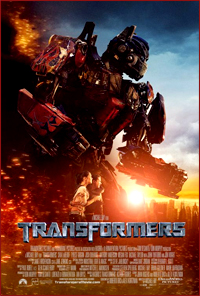 Watching the live-action adaptation of Transformers, one sits and wonders if Michael Bay will deliver on the franchise’s famous promise of being “more than meets the eye.” In many ways, the film delivers. But in others, it feels like it’s all been done before.
Watching the live-action adaptation of Transformers, one sits and wonders if Michael Bay will deliver on the franchise’s famous promise of being “more than meets the eye.” In many ways, the film delivers. But in others, it feels like it’s all been done before.
Even though it feels like you’re a third of the way through the movie before you get a chance to get a good look at one of them, the three-story robotic monstrosities known as the Transformers are a marvel of visual effects work. Hats off to Industrial Light and Magic for their innovations in kinematics that allow for the explosive unfolding and reassembling of complicated machinery into the heroes and villians we’ve grown up with.
No detail is spared in the transformations. Several close-up shots demonstrate the complex but true-to-form physics of displaced joints and appendages. You literally see the gears turning. And, of course, they sell it by adding the infamous “chh-chh-chh-chh!” noise that countless little boys made themselves when playing with the toys growing up. Good call.
Bonus points as well go to giving the role of Optimus Prime to Peter Cullen (who originated the character in the cartoons). Hearing his rich baritone deliver Optimus Prime’s lines just feels right – like an old pair of slippers (even if Cullen had to audition twice (!!!) to get the role).
As a side-note, there was some fan outrage when the role of Megatron was turned over to Hugo Weaving, but it’s a non-issue. Weaving does some interesting things with the tight-lipped Aussie snarl he perfected as Agent Smith in The Matrix Trilogy. You won’t even recognize him until he’s on screen for a good 10 or 15 minutes. No disrespect to Earl Hammond (who originated the role of Megatron in the cartoons), but his addition probably would have put the film over the top in terms of cartoonishness.
Not that Bay doesn’t do a good job of that on his own. Carrying his signature style (sweaty and grimy heroes walking in slow-motion against back-lit scenery) the action sequences deliver full-throttle excitement. There is always something awe inspiring to look at. If you would have flipped on the lights during the Optimus Prime/Bonecrusher fight over the Los Angeles freeway, I’m sure you would have seen a sea of slack-jawed amazement. Sometimes it’s almost impossible to soak it all in as Bay brings the battle in close for a robot-on-robot death match. Speed, fluidity, and explosive force are all hallmarks of his trade and there isn’t a movie better than Transformers for Bay to use his entire bag of tricks.
However, for everything that the movie does right, there are areas that come up short. Specifically, the screenplay. Five writers had their hands in this thing and it shows. Anytime a character speaks, they really shouldn’t because most of what they say are melodramatic cliches.
As far as the performances are concerned, Shia LaBeouf as the lead knows his role is to act as our witness – to allow the story of the Transformers be told through his eyes. At times his delivery comes off like a spastic Vaudeville routine. A lot of fast talking and stumbling over his words. But he holds his own.
Megan Fox as his romantic interest offers little than a sweaty midriff to look at. She looks half-asleep through most of the movie. Her background as the daughter of a grease monkey felon is inconsequential and only inserted to mask the fact that she’s only along for the ride as arm candy.
Josh Duhamel is serviceable as an Army Ranger who’s squad first encounters the Transformers in the desert of Quatar (ooo, topical!), but he’s no Timothy Olyphant. Tyrese Gibson as his war-buddy is pretty much there to taunt the evil Transformers after calling in an air strike with the summer’s newest non-catchphrase “Bring the rain!”
There’s a curious amount of military involvement in the film, which felt odd at first for a science-fiction movie about giant robots. But considering this is an alien invasion of sorts, the response is appropriate. Maybe it just feels odd since the original cartoons never really addressed the human response to Transformers being on Earth. They carried out their war in our backyards pretty much undisturbed. But if you’re applying real-world logic to the film, the government would be on this pretty quick.
Seeing all of the tanks, jets and helicopters made available to Bay by The Department of Defense, it’s easy to see why Bay has a strong following among the NASCAR set. He makes the soldiers out to be more quick-witted, heroic and ass-kicking than Rambo. I’m not saying we couldn’t use a little positive representation of our men in uniform, but I was surprised at the level of American gung-ho spirit in a movie whose source material comes from Japanese robots.
That said, there’s almost too much military action. There’s so much at the beginning, we’re not introduced to Shia’s character until almost 40 minutes in. By the third act of the movie when John Tuturro and his secret government agency that smells like a Men In Black rip-off shows up, the film veers dangerously close to plagiarizing Independence Day when it’s revealed how much the government knew and when they knew it.
If I could express any other complaint about the movie, it would have to be the amount of product placement that Bay can’t seem to divorce himself from in his films. From eBay to Burger King to each of the good-guy Transformers depicted as GMC vehicles, the stamp of marketing executives are all over this film. At one point, there is a convoy of all the vehicles that looks like a commercial I’d see while watching The Office. Lens flares, close-ups of the GMC logo, swooping overhead shots from a helicopter. I leaned over to Cami and whispered “The all-new 2008 Bumblebee with 0% financing and factory rebate!” Hell, even a Nokia phone and a Mountain Dew vending machine transform into robots! Of course, the movie itself is a gigantic commercial to sell toys. It pretty much tells you as much in the opening credits when it reads “In partnership with Hasbro.”
Ultimately, Transformers is a big, dumb Hollywood action movie that brings the fireworks for the Fourth of July holiday. It doesn’t disservice the characters I grew up with and loved as a child, but it really doesn’t bring anything new to them other than the amazing photo-realistic transformations in the effects work. If you like Bay’s other action movies, you’ll love this one. If you’re not already a fan, there’s nothing here that will convert you. Take Transformers with a grain of salt and you’ll have a rollicking good time at the movies.
![]()
In early spring, a movie was unleashed upon the American public that unexpectedly spawned a dozen quotable catchphrases and launched a thousand internet parodies. It went on to make over $210 million at the box office, shocking industry analysts with it’s shocking violence, beautifully choreographed fight sequences and wide audience appeal.
That movie was 300 and I was on the sidelines for the whole thing.
Just as the hype surrounding the film was beginning to build, we brought our first child Henry into the world. It didn’t really fit within my priorities at the time to saunter off and wallow in a swords and sandals splatter fest while Cami was home changing diapers.
But I was able to get my hands on an advance copy of the film – out on DVD today – and this is my review.
By now you’re probably familiar with the battle of Thermopylae between 300 Spartans and the invading Persian army. The film bases it’s story around these events, but never pretends for a minute that its historically accurate. Instead, it draws an immediate line between itself and Frank Miller’s graphic novel of the same name.
Several key frames from the graphic novel are recreated in loving, gory detail here. I used to think that a previous Frank Miller creation – Sin City – was the most faithful comic book to movie translation. It’s evident that directory Zach Snyder has studied the approach to Sin City and refined it in 300.
The action on screen is constantly engaging and Snyder makes sure to slow things down just enough for you to feel each slice of the blade as it drags across human flesh. Knives bury themselves deep in eye sockets and heads are lopped from torsos with regularity – they float in the air like a bride’s bouquet.
Despite the film’s love affair with gore and it’s unwillingness to shy away from any of it, I couldn’t help but feel somewhat detached from the proceedings. I don’t know if the film has possibly lost some of it’s impact being wedged onto the small screen, but what transpires feels very much like a video game. Blood splatters everywhere and seems to almost evaporate. I was surprised when slain Persians simply didn’t blink a few times in rapid succession before disappearing from the battlefield to make way for more Spartan slaughter. But it’s probably not best to worry about it too long.There is more carnage to be had!
For me, the success of the film rests squarely on the broad shoulders of it’s star Gerard Butler as King Leonidas. Much more than a pointy beard, some eyeliner and rippling pectorals, Butler attacks his dialogue with the corners of his mouth pulled down to the base of his neck in vein-popping earnestness. He carries himself confidently and projects strength at all times. Watching him, you’re convinced that this is a man that could rally soldiers to battle and prepare them for death and glory as if there were no greater reward. He’s a treat to watch because he takes all of it as seriously as a heart attack. In less literal hands, Leonidas could have come off as pompous or unreasonable.
Beyond Butler’s scene chewing, the narrative is delivered largely in voice over. The third person account lends a sort of historical reverence to the proceedings, but at the same time feels pat and lazy storytelling. Some political maneuvering is thrown into the background of the plot, but it does little to anchor itself to the action at the battle of Thermopylae. Ultimately, it’s the visuals that sell the movie. Shot almost entirely against a blue screen in Montreal in 60 days, one marvels at how it was all assembled to recreate the epic battle.
Not much is explained in terms of extras available on the full screen version of the DVD that I was provided with. Just a simple director’s commentary and that’s all. The widescreen edition doesn’t fare much better for extras, but the two-disc special edition contains more than 90 minutes of addition footage that delves into the “How’d they do that?” for a richer at home experience.
FX junkies looking for an unapologetic action film will find much to love in 300. Anyone looking for greater depth will probably have more luck watching The History Channel.
![]()
In what has to be one of the most agregious oversights in pop culture last year, Tina Fey’s excellent freshman sitcom 30 Rock languished at the bottom of the ratings while brain dead reality shows and game shows involving no skill dominated. America – If you’re complaining that there is nothing good on TV, you have no one to blame but yourself. Hopefully, with the first season now on DVD, you can get caught up before the second season premiers on October 4.
30 Rock was one of two behind-the-scenes-at-a-sketch-comedy-show offerings NBC had on its schedule last year. The other was the now-canceled Studio 60 on the Sunset Strip. Perhaps confusion kept people away from 30 Rock or perhaps its poor scheduling against powerhouses like Survivor and Grey’s Anatomy led to it being overlooked. But it doesn’t subtract from the often witty, topical and sometimes absurd story lines. Whatever shape it takes, it’s always funny.
Fey, as the series producer, head writer and star, does an excellent job portraying the beleaguered Liz Lemon as a kind of post-modern Mary Tyler Moore. Things start to come off the rails when a brash network executive played by Alec Baldwin forces Lemon to hire an out-of-control movie star played by Tracy Morgan to spice up the show.
The initial premise of the show causes some interesting conflict from which comedy is mined, but it begins to drag somewhat when you realize that Tracy Morgan’s antics are best in small doses.
Some flashes of brilliance are seen in the series third episode “Blind Date” when Baldwin’s character sits in with the shows writers and is drawn into their weekly poker game. Cleaning everyone out thanks to his shark-like ability to “read” people. But when he is confronted with the eternally upbeat Kenneth, the studio page (Jack McBrayer) who he cannot “read”, he sets out to mentally destroy him.
However, it isn’t until the shows’ seventh episode that it really hits its lunatic stride. When Baldwin’s character puts Tracy Morgan on Conan O’Brien, it’s a race against the clock to put Tracy back on his medication before he repeats an unfortunately near-stabbing like he did the last time he was on Conan. Between executive producer Pete’s new-found self-confidence through wearing a wig, Tracy’s hallucination of a little blue man and the introduction of Dr. Spaceman (that’s pronounced “Spa-chem-in”), the series cements it’s stance in finding absurd laughs in everyday occurrences.
DVD extras in the collection are somewhat paltry. There’s your standard deleted scenes and blooper reel, but they just kind of sit there. The blooper real is wrapped up in a kind of fake “E! Hollywood Story,” which would have been better if they had seen the concept of the parody all the way through.
“An Evening with Kenneth” are a series of shorts that the actors made while in character featuring Jack McBrayer as Kenneth the page hosting his own late-night comedy show. A few chuckles, but nothing more.
What I was curious to see was the original pilot of the series that featured Rachel Dratch as Fey’s best friend and star of the show-within-the-show. But she was bumped by network executives and replaced by the acceptable Jane Krakowski. What’s the matter, NBC? Afraid we’d see the folly of your mistake?
It should go without saying that the extras are not the reason to buy this collection. Buy it for some excellent original comedy. Disciples of Arrested Development and The Office will find plenty to like here. With any luck, Baldwin’s Golden Glove for Best Actor and the series Emmy win for Best Comedy Series will help drag it out of the ratings quagmire for season two.
Like John Irving or Alan Moore, Steven King is one of those writers who can’t seem to catch a break when it comes to the translation of his ideas to a visual medium. For every Misery, there’s a Thinner. One could argue that the best Stephen King adaptation contained the least amount of his vision. Stanley Kubrick’s version of The Shining stands a a beacon of psychological horror.
Maybe there’s less to be said about the filmmaker’s role in these adaptations as there is to say about King’s choice in subject matter. 1408 – originally a short story about a haunted hotel room – is another great piece of psychological horror that stands just below The Shining in it’s effectiveness.
In 1408 (on 2-disc DVD on October 2), John Cusack stars at Mike Enslin, a jaded author who abandons his wife after the death of their daughter writing travel novels about haunted hotels. He has become jaded in his travels and is thoroughly convinced that there is no such thing as an afterlife.
After another unsuccessful trip, he receives a mysterious postcard from The Dolphin Hotel in New York with the foreboding warning “Don’t enter 1408.” Intrigued, Mike begins to do research about the room’s grisly past.
It isn’t long before Mike is in New York squaring off against Samuel L. Jackson as the hotel manager Gerald Olin doing everything in his power to prevent Mike from staying in room 1408. He offers to upgrade him to the penthouse, bribes him with an $800 bottle of cognac and even gives him complete access to the hotels files on all the guests who’ve perished in the room so he will write his story and leave.
Jackson delivers an expertly grim performance as Olin. But only do the production diaries (an extra on the DVD) reveal the genius of his casting.
As written, Olin was a short, chubby white man of European descent. It was Quentin Tarantino who first suggested Jackson when he was given first pass at the script. An interview with Cusack summarizes things quite well. “If a English bellhop tells you ‘Don’t go in the room.’ you’re gonna go in the room. But if Sam Jackson says ‘Don’t go in the room.’ you DON’T want to go in the room. He’s a good crypt keeper. If it’s enough to scare Sam, it’s gonna scare you. So he gives it a kind of existential street cred.”
For all intents and purposes, the movie is being held up almost entirely by Cusack’s talent. Trapped in 1408, he is given nothing to interact with except the environment. As the room starts taking the shames of his past and using them as weapons against him, there is only Cusack there to convince you of the harrowing plunge into his own mind.
The first half of the film is effectively terrifying as director Mikael Håfström squeezes every last drop of tension from the commonplace surroundings of 1408 to keep you on edge. In what the film refers to as “the banality of evil,” you feel more fear waiting for something to leap out from the shadows than you do when things finally come off the rails and the haunted room starts to throw everything it has at our hero. To put it another way, after watching this movie you’ll never feel the same about “We’ve Only Just Begun” by The Carpenters ever again.
I have a great deal of respect for this film. Not just for the performances or it’s director, but for the expert production design and effects work. Again, the production diaries reveal a great deal of 1408’s secrets and exactly what went into making such a confined space work in a horror setting.
Additional extras on the DVD are standard fare. Deleted scenes, webisodes, trailers and commentary from the writers and director. The film comes with both the theatrical cut and the extended directors cut with an alternate ending. I won’t spoil it for you, but the alternate ending isn’t much different from the original. It just adds an extra joy-buzzer jolt. So including it to add value to the purchase is somewhat superfluous. Cleverly, the packaging comes with fake postcards from The Dolphin inviting guests to stay in the room of the dammed.
Ultimately, 1408 probably will not stand shoulder-to-shoulder with a film like The Shining, but Stephen King should be proud of the adaptation nonetheless. It is great entertainment that represents him well.
DVD REVIEW – GRINDHOUSE: PLANET TERROR
October 16th, 2007 | by Tom









(5 votes, average: 6.00 out of 10)
When Grindhouse came out in theaters back in April, I wasn’t able to see it in theaters as I was busy taking care of a newborn son. At the the time I felt badly that I wasn’t able to participate in what was supposed to be the great film geek-out of the spring. But as word spread, I was actually kind of relieved. Not because neither of the two films that made up the double feature were bad movies. But from everything I heard, the fim’s first half – Robert Rodriguez’s Planet Terror – was a goopy, gory mess and I wasn’t enchanted by the idea of being trapped in the theater for an hour and a half before getting to see Quentin Tarantino’s contribution in Death Proof.
I’m not a great fan of zombie movies, excessive gore or things that jump out of you looking for a cheap scare. Familiar with Rodriguez’s work in Sin City and From Dusk Till Dawn, I knew that there wasn’t the explicit whim of his inner 14 year-old that Rodriguez wasn’t adverse to indulging. You can imagine my anxiety sitting down to watch Planet Terror – available extended and unrated on DVD today, October 16.
The plot is typical zombie fare. A greedy bio-chemist played by Lost’s Naveen Andrews unleashes a chemical agent on a small Texas town that turns it’s residents into the walking dead. It’s up to a rag-tag group of misfits to fight their way to safety.
True to form, Rodriguez heaps on the carnage and mayhem. There isn’t an explosion too large or a sound effect to squishy or crunchy to be used in his arsenal. Everything in this movie is turned up to 11. When zombies are shot at, they explode like ripe water baloons filled with plasma.
What the movie lacks in subtlety, it more than makes up for with it’s excellent cast. Six Feet Under’s Freddy Rodriguez turns in a surprising and commanding performance as the mysterious El Wray. Michael Biehn shows up as the town’s true-grit sherrif and Jeff Fahey shows up as his BBQ-obsessed brother. Bruce Willis plays it straight as a tough-talking army general and Rose McGowan, her acting somewhat wooden, creates one of modern cinema’s most indelible heroines in Cherry Darling – the go-go dancer/amputee with a high-powered machine gun for a leg.
In terms of visual excess alone, Rodriguez delivers the spirit of Grindhouse cinema. I can’t compare this extended version to the theatrical release because the DVD fails to include both. But nothing here feels overtly extrenious or draining to the film’s running time.
The DVD comes with an excellent collection of extras on the second disc including Rodriguez’s traditional “10 Minute Film School.” In it, he reveals a lot of the tricks used in the film to achieve it’s large number of practical effects. Everything from the explosions, the car wrecks, to composit shots and the CG magic behind the infamous machine-gun leg.
In “The Badass Babes and Tough Guys of Planet Terror,” we get to see how the casting of each of the roles influenced Rodriguez’s script as he was writing it. There is some slight discomfort listening to Rodriguez effusive praise of star Rose McGowan’s prowess performing her own stunts as well as what personality quirks she added to Cherry Darling in her ad libs. Considering the on-set affair the two of them had that resulted in the end of Rodriguez’s marriage to his wife and co-producer, Elizabeth Avellan, it feels like some of that could have been scaled back.
It gets more unsettling still as an entire bonus feature titled “Casting Rebel” focuses entirely on Rodriguez’s casting of his youngest son Rebel in the role of Marley Shelton and Josh Brolin’s son. “Meet your new Mommy, Rebel! She has a machine gun for a leg!”
All in all, those looking for a visceral thrill will find more than enough to wrestle with in Planet Terror. While the movie is intense, my initial fears of the movie being TOO intense were unfounded. Rodriguez injects just enough humor into the script to keep the scales from tipping over completely – All the while pushing the film into greater and greater parody of itself. At the point that Quentin Tarantino’s infected solider affectionally credited as “The Rapist” comes on screen, you’ve pretty much given yourself over to the cartoonish ridiculousness of things and just enjoy the ride.
Watching the Transformers two-disc special edition on DVD feels like an unfairly muted experience. A spectacle of this proportion is better served on the big screen. I reviewed the film during it’s theatrical release and found most of the problems I experienced in that initial viewing remained intact. The plot is spread too thin over too many characters. There are logic and pacing problems and there is still too much signature “Michael Bay-ness” in the film to endear itself to me.
One thing I became more forgiving of was the designs of the robots. Engulfing your entire field of vision on the big screen, the bodies of twisting, twitching metal were tough to identify. Confined to your TV, Optimus Prime and the rest of the Autobots become more manageable and recognizable.
As the movie progresses to it’s big downtown battle sequence, I found myself even more impressed with the complexity of their design and the fluidity of their movements. Once you get past the knee-jerk “But Ironhide doesn’t look like that!” reaction from your childhood, these modern updates makes more and more sense.
That aside, the two-disc edition includes an excellent set of extras on the second disc. Two hour-long documentaries broken into different chapters detail brilliantly the filming of the movie from concept to completion.
ILM comes off looking the best explaining the Transformers look and feel – how they developed the complex programming that gave every last nut and bolt a place to fold and lock into shape between vehicle and robot transformation. The detailing given to each character down to every last nick and scratch is the hallmark of this film.
The writers of the film – Roberto Orci and Alex Kurtzman – do a good job of explaining why some robots made it into the film and others didn’t. They also made a good case for fan favorite transforming into an “alien jet” and not a more terrestrial vehicle – more glaringly, why he doesn’t transform into his signature form, a Walther P-38 handgun.
“We decided there would be no mass-displacement in the movie. Megatron can turn into a gun in the cartoon and you don’t think twice. But we found in the movie that Megatron turning into a gun was the equivalent of Darth Vader turning into his lightsaber and having someone else swing him around.”
Although they make no explanation about the mass-displacement of the condensed Allspark, they make a good point about Megatron.
Between the writers and the animators, there is clear affinity for the characters and an understanding of their histories. But not everyone comes off so well. In their interviews, Michael Bay, Shia LaBeouf executive producer Steven Spielberg and representatives from Hasbro all look like money hungry opportunists trying to revive a 20 year-old franchise. It’s really not worth going into detail, but more often than not, you get the sense that these parties are looking down their nose at the geek culture that spawned this level of success for their film.
Despite the general unpleasantness Bay exhibits on a regular basis (yelling his direction through a megaphone is one of his more “charming” traits) you have to give credit to him as someone who knows how to deliver a visceral thrill and for insisting on doing it with practical effects. Watching the behind-the-scenes on how many of these complicated shots were achieved makes the film a much richer experience and makes the two-disc edition well worth the money.

When Michael Moore’s Sicko was in theaters earlier in the year, it had a hard time connecting with audiences and $24 million take at the box office was considered a “failure” in comparison $120 million take of Fahrenheit 9/11 only three years prior.
Maybe people weren’t interested in the controversy Sicko generated. Maybe they had grown tired of the conservative vs. liberal debate that nearly every pressing issue has devolved into. More likely than not, they probably felt so overwhelmed and powerless in the face of the medical systems, they didn’t have much hope that a documentary could unravel its riddle.
There is no question that Moore had his work cut out for him when making Sicko. But he approached the concept of the broken American health care system in a very democratic way. Soliciting for personal stories from visitors to his web site, Moore gathered over 25,000 e-mails detailing the frustration and hopelessness this small sample of American citizens faced when trying to acquire reasonable health care.
Now Moore was faced with the problem of telling 25,000 stories.
Some stories serve for a laugh. One man who sought to provide his daughter with an ear implant was denied coverage, but found his insurance provider willing to change their stance on the issue by merely bringing Moore’s name into the conversation. “Has your CEO ever been in a film before?” he asked. His daughter got the implants.
Another woman told the story of being charged by her insurance company for being taken to the hospital in an ambulance after a car accident because the ambulance ride was not pre-approved. “I don’t know when exactly I was supposed to have it pre-approved,” she says. “Was it after I regained conciousness in the car and before I was placed in the ambulance?”
Some stories serve to shock. Moore talks to individuals who worked within the health care industry who were hired to turn sick people away. An investigator that would go through ever record imaginable to find out if you failed to disclose a pre-existing condition. A call center worker giving quotes to sick people over the phone, but knows they’ll be denied due to medical history – bound from saying anything to prospective customers. A medical reviewer who reveals she was instructed to maintain a 10% denial rate and that doctors with the highest rate of denials would actually receive a bonus.
Time and time again, Moore serves to us examples of a health care industry run amok and the political powers that be that have allowed it. Neither Democrats or Republicans get off lightly in his expose. Hillary Clinton, for example, once the greatest proponent for universal health care in the early 90’s is now the second largest recipient of campaign donations from the health care industry.
But Moore isn’t simply finger pointing in this movie. There is plenty of blame to go around. From the insurers to the pharmaceutical companies, to the lawyers, lobbyists and the politicians. Everyone is taking their cut.

Moore wanders into dangerous territory when he starts to travel abroad. Comparing the American health care system to those of Canada, England and France, he’s been chastising for making them look like some kind of utopia.
If I could editorialize for a minute, this is where Moore’s critics get it all wrong. Assuredly, he is only showing a piece of the whole picture. But he’s doing it to incite a specific emotional response not unlike any other filmmaker or any other documentarian for that matter. It’s not journalism. It’s whistle blowing – and it’s two different things.
Granted, things start to step out of line when Moore takes three Ground Zero rescue workers to Guantanamo Bay, Cuba for medical attention. Captured enemy combatants – terrorists, he claims – get better health care than the men and women who risk their lives after 9/11.
But once he arrived in Cuba to seek medical treatment from the country’s free health care system, the footage speaks for itself.
The rescue workers were asked for the names and nothing more. A full battery of tests were performed on each of them. Thorough diagnoses and health plans to follow when the returned home were given to them. For one woman with respiratory problems, she was given inhalers for free that would have cost over $120 in the United States.
The point, Moore states, is that even in the supposedly “worst” countries like communist Cuba – if they can take care of the sick, an “enemy” no less, without thought or question to who will pay for it, then why isn’t that something American policy makers can adopt?
I think regardless of where your personal politics lie or even what you think of Moore as a filmmaker (or muckraker, whatever you prefer) most people can agree that the American health care system is not the best it can be. For your own education, Sicko is an easy an access point to understanding a complex issue that you’re likely to come across. Even if you don’t agree with it, maybe it’ll prompt you to do your own research. A few more voices asking questions never hurt.
“If we see a good idea,” says Moore. “We take it. If they build a better car, we drive it. If they make a better wine we drink it. So if they’ve found a better way to take care of their sick, to teach their kids, to take care of their babies… then what’s our problem? Why can’t we do that?”
The logic is hard to refute.
The other night I saw a documentary that, if left to my own devices, I probably would not have saught out. But thanks to a few friends in the medical community, I attended an advanced screening of The Business of Being Born – an eye opening look into how babies are delivered in the United States.
I didn’t expect to like the movie as much as I did. Birth plans? Doulas? Even as a parent – as a man, some of these concerns felt out of my grasp. But the film does a good job of identifying the needs of women in the larger context of the hospital system making the issues there-in less of a “women’s issue” or even an issue for expectant couples – but a human issue.
Like any good documentary, the film is rife with interesting facts and statistics. For example, in the 1900’s, 98% of children were born at home. But after the industrial revolution, medical colleges were spitting out more obstetricians than the country knew what to do with. By the 1920’s, hospitals were participating in active smear campaigns against midwives depicting haggard gypsy women as unclean vestiages from “the old country” and offered hospitals as a gleaming, white mecca for safe delivery. By the 1950’s only 1% of births in America were at home. A statistic that stands firm to this day.
Despite the fact that my own son was delivered with the help of a midwife (one whose practice was associated with a hospital, but operated independently), the stigma against midwives still floats around in my brain. Just mention the word and images of water births and waving wolfsbane over a woman’s head come to mind.
There is certainly a little bit of this “granola” way of thinking on display in the movie among the midwives that are interviewed. There is a lot of talk about an “authentic” birth experience among the mothers-to-be. These converstations take on a less endulgant neo-hippie tone when faced with the business protocol of most hospitals.
As characterized by the movie, hospitals are businesses that – not unlike hotels – are more interested in filling beds and turning them over and, typically, if a woman’s delivery does not fit within a certain window of time, doctors perform escalating levels of “interference” from synthetic hormones to major surgery in order to prompt the delivery of the child.
Probably most shocking are the films statistics regarding c-sections in the last 10 years – which have seen a dramatic increase. In some hospitals, the highest number of c-section deliveries spiked at 4:00 in the afternoon and 10:00 a night. A clear indication – they claim – that doctors and hospitals are not about seeing a woman through a natural process, but treating pregnancy clinically, as if it were a disease. Practices that put both mother and child at risk and have lead the United States to the second worst infant mortality rate in the developed world.
The film doesn’t spend it’s entire time lobbing shocking examples of the medical system’s failures at you. It balances things out by following several women down the path of their deliveries, which brings the film a real sense of humanity. Typically disturbed by the graphic footage of deliveries I’ve seen on television in the steril surgical environment of hospitals, births became much less shocking and violent than pleasantly surprising and relaxed in the context of home births.
At the same time, the film does not dismiss what doctors do completely. The film’s director, Abby Epstein, became pregnant during production and had planned on an at-home birth before her midwife determined that the baby was breach and she need to be rushed to a hospital. So even for someone advocating a certain line of thinking, the value of professional, medical care is a still an important factor.
More than anything else, the film inspires couples to ask more questions about their options rather than accepting the authority of medical professionals with blind faith. There is a time and place for hospitals. But, by in large, going to a hospital to deliver a baby is overkill. A woman’s body knows what to do.
The Business of Being Born is currently in limited release, but keep your eyes open for it later in the year.

“The Best Reviewed Movie of the Year!”
That’s what the sticker affixed to the DVD jacket of Ratatouille says. It’s referring to the 97% positive rating the movie earned from the reviews collected by RottenTomatoes.com.
The claim is somewhat dubious. The Pixar name alone is almost synonymous with quality. But within five minutes of watching the film, you understand why it is so highly regarded.
Ratatouille is the second paring between Pixar and director Brad Bird and their effort is as good, if not better than their previous film – 2004’s The Incredibles.
The movie is centered around Remy (voiced by Patton Oswalt), a passionate French rat with a highly developed sense of smell and taste. Remy dreams of an existence beyond scavenging for trash with his dim-witted brother (Peter Sohn) and loutish father (Brian Dennehy). He fantasizes about being a 5-star chef, like his hero Gusteau – a celebrity chef whose book “Anyone Can Cook” Remy has been stealing glances at in the home his family hides out in.
Remy’s life changes dramatically the day his family is discovered by a shotgun wielding grandma and he is flushed down a storm drain into the sewers under Paris. His family lost, he emerges top side in front of Gusteau’s world-famous restaurant. Kismet at it’s most unlikely.
From there the movie kicks into high gear as Remy forges an unlikely alliance with a lowly garbage boy named Linguini whose ambition to cook is offset by his complete lack of talent. By pulling locks of his hair to manipulate his arms, Remy puppeteers him into creating fantastic dishes that excite the restaurant’s patrons and brings glory to our heroes.
There is conflict with the Napoleonic head chef Skinner (an unrecognizable Ian Holm) who has taken over for the now deceased Goustea and with Anton Ego – a rail-thin ghoul of food critic who refuses to swallow anything he finds unpalatable. Peter O’Toole as Ego delivers a mesmerizing, menacing performance that transforms the character from more than a mere food snob into a frightening threat.
What follows is a predictable arc about pride, humility, teamwork and family. But woven throughout the film are much more rich subtexts about creativity, authenticity and passion – both good and bad.
Gusteau’s motto that “anyone can cook” is pervasive throughout. One must only have the desire to cook, to experiment, to be successful. If one is brave and injects their heart into what the love, they can create beautiful things. It’s a life-affirming message and applicable to all forms of artistic expression.
Alternatively, Brad Bird pulls no punches against the critic character Anton Ego whose passion for food has corrupted his ability to appreciate it at all. Scathingly, Bird identifies critics at large to mostly irrelevant and the potential death nail to creativity. Everything from Ego’s tone, to his look, to his coffin shaped office and grim hollow typewriter facade that looks like a human skull re-enforce this.
It goes without saying that the film is a seven course meal for the eyes. Pixar continues to refine its technology to the point where water effects and the rendering of hair and fur look nearly as good as the real thing.
The DVD’s extras are surprisingly thin for a film experience so sumptuous. Two hilarious animated shorts, the theatrical feature “Lifted” and the DVD exclusive “Your Friend the Rat” are excellent. The three deleted scenes animatics introduced by Brad Bird are less so.
The last and most interesting extra on the DVD is the 15 minute documentary “Fine Food and Film: A Conversation with Brad Bird and Thomas Keller.” Keller is a name familiar to foodies. A world-famous chef, he was a consultant on Ratatouille and the signature dish in the film bears his signature for its unique preparation.
The documentary explores the unlikely similarities between animation and cooking as Bird and Keller separately discuss inspiration, collaboration and mentorship. There are several valuable insights. Producing more extras like this would have made the supplemental material much more satisfying.
Obviously DVD extras do not a successful film make. But for an animated feature that is so lovingly crafted, it would have been a real treat to explore more of the process and effort that went into its creation.
We may never understand all of the mysteries that lead to great art. But in any case, my compliments to the chef.

